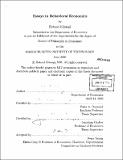| dc.description.abstract | Chapter 1: This chapter examines the logical consequences of the rather unsurprising notion that humans care about and manage their self-image, a notion long taken for granted by psychologists. I model this by assuming that decisionmakers derive utility from positive views about the self, holding constant standard utilitarian outcomes usually assumed relevant in economics. Other than this, agents are timeconsistent expected utility maximizers, are constrained in their updating by Bayes' rule, and can manipulate their beliefs only by controlling the flow of information that they receive. The motive to maintain a favorable self-image leads to a systematic rejection of free information about the self in certain states of the world and eventually to overconfident beliefs. Economically relevant decisions are affected by this overconfidence as well as the incentive to gather information about and make decisions so as to optimally manage beliefs. Agents might avoid informative actions when satisfied with their current beliefs ('self-image protection'), and seek out activities in which they can prove themselves when they are not ('self-image enhancement'), even if these choices are otherwise poor. These motives lead to a whole host of effects on behavior that other models have trouble explaining in a unified framework. The model can also make testable predictions on how these effects play themselves out across different categories of tasks and within a category of tasks over time. Applications to stock market participation, the choice between salaried and self-employment, career choice, manager behavior, and employee motivation are discussed. Chapter 2: This chapter starts from the same premise as the previous one, the assumption that agents care about their self-image, but examines its consequences in a different information structure. Agents can improve financial decisions by making subjective judgments about their payoffs, while they derive ego utility from their perceptions regarding this ability. If the agent has a self-image protection motive, she will as a result be averse to making a subjective judgment and reviewing it later, since this combination is informative about ability. The consequence could be a sluggishness in responding to new information, procrastination in making up one's mind, or the reliance on inferior objective information. Possible remedies and applications are discussed, with particular attention to anxiety about health. Chapter 3 (with Peter Diamond): There is overwhelming psychological evidence that some people run into self-control problems regularly, yet the effect of these findings on major life-cycle decisions hasn't been studied in detail. This paper extends Laibson's quasi-hyperbolic discounting savings model, in which each intertemporal self realizes that her time discount structure will lead to preference changes, and thus plays a game with her future selves. By making retirement endogenous, savings affect both consumption and work in the future. From earlier selves' points of view, the deciding self tends to retire too early, so it is possible that the self before saves less to induce her to work. However, still earlier selves think the pre-retirement self may do this too much, leading to possible higher saving on their part and eventual early retirement. Thus, the consumption path exhibits observational non-equivalence with exponential discounting. Observational non-equivalence also obtains on a number of comparative statics questions. For example, a self could have a negative marginal propensity to consume out of changes in future income. The outcome with naive agents, who fail to realize their self-control problem, is also briefly discussed. In that case, the deciding self's potential decision to retire despite earlier selves' plans results in a downward updating of available lifetime resources, and an empirically observed downward jump in the consumption path. | en_US |

